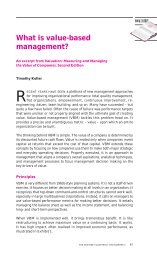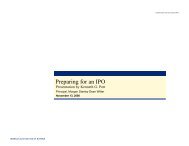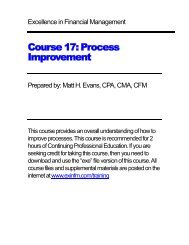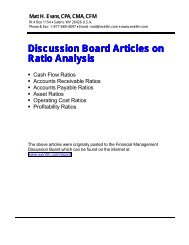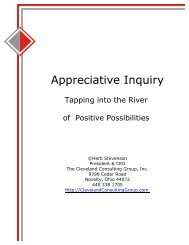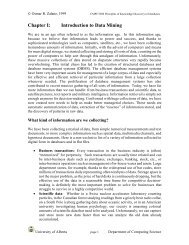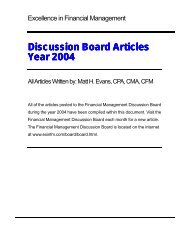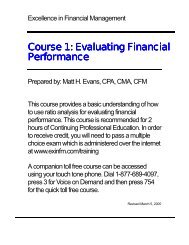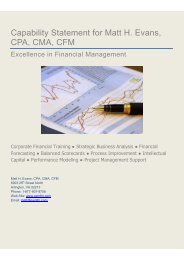Short Articles (PDF) - Excellence in Financial Management
Short Articles (PDF) - Excellence in Financial Management
Short Articles (PDF) - Excellence in Financial Management
Create successful ePaper yourself
Turn your PDF publications into a flip-book with our unique Google optimized e-Paper software.
Focus on Free Cash Flow, not EBITDA!<br />
When analyz<strong>in</strong>g and determ<strong>in</strong><strong>in</strong>g values, there is a tendency to use shortcuts or<br />
recommended calculations. For example, Cash Flow Return on Investment is<br />
advocated by some while others like to measure value by calculat<strong>in</strong>g EBITDA -<br />
Earn<strong>in</strong>gs Before Interest Taxes Depreciation Amortization. The problem with these<br />
approaches is that they tend to bypass "free" cash flows. And free cash flows are the<br />
source of valuations.<br />
Th<strong>in</strong>k of free cash flow as the amount of cash you can draw out of your organization<br />
after you've paid everyth<strong>in</strong>g off. This is the amount you want to use for determ<strong>in</strong><strong>in</strong>g<br />
value. If you were to use EBITDA, you would falsely assume that the asset base will<br />
be systematically capitalized over time with no future additional re<strong>in</strong>vestments <strong>in</strong>to<br />
assets. How long can your organization generate future revenues with a decl<strong>in</strong><strong>in</strong>g<br />
asset base Consequently, you need to be careful about fashionable ways <strong>in</strong><br />
arriv<strong>in</strong>g at valuations. Get back to Cash Flows. If you want to rely on the Income<br />
Statement, than add back non-cash items such as depreciation and subtract out<br />
future work<strong>in</strong>g capital requirements and future capital <strong>in</strong>vestments. Don't shortcut<br />
your analysis; go back to how you arrive at cash flows.<br />
Valuation of Customers – Part 1<br />
Most bus<strong>in</strong>esses recognize the importance of customers. However, few<br />
bus<strong>in</strong>esses will recognize customers like any other asset, assign<strong>in</strong>g value to<br />
customers and categoriz<strong>in</strong>g this asset as the ma<strong>in</strong> asset for runn<strong>in</strong>g the<br />
bus<strong>in</strong>ess. When you treat customers like an asset, you beg<strong>in</strong> to manage<br />
differently. For example, some customers add value to the bus<strong>in</strong>ess while others<br />
remove value from the bus<strong>in</strong>ess. For those that add value, more resources are<br />
allocated to these types of customers. The net losers are transferred to the<br />
competition. Reta<strong>in</strong><strong>in</strong>g the highest value-creat<strong>in</strong>g customers is the primary<br />
objective beh<strong>in</strong>d assign<strong>in</strong>g values to customers.<br />
The value assigned to customers is based on the future net profits generated by<br />
a customer, discounted back at the cost of service rate to a net present value. In<br />
some cases, it is necessary to account for additional values contributed by<br />
customers. For example, suppose you have a customer that refers new<br />
customers to your bus<strong>in</strong>ess or suppose you have a customer that is provid<strong>in</strong>g<br />
you with valuable feedback for improv<strong>in</strong>g your services. These types of customer<br />
attributes generate higher values.<br />
When calculat<strong>in</strong>g net present values for customers, you will need to estimate the<br />
full costs of servic<strong>in</strong>g the customer. This requires a cost allocation system, such<br />
as Activity Based Cost<strong>in</strong>g with an object layer that captures net profits by<br />
customer. S<strong>in</strong>ce most cost models will be hard pressed to capture all customerrelated<br />
costs, you will probably have to apply some probabilities to certa<strong>in</strong> cost<br />
32



